That first marlin: it’s a significant angling milestone, certainly on every fisho’s bucket list, and there’s no better time to do it than right now. Billions of words have been written on how fantastic they are to catch, but let’s look at some basics to get you successfully hooked up for the first time.
We’re looking at black, striped and blue marlin along the east coast of Australia, and maybe a stray spearfish or sailfish if you’re lucky. Outside of the Cairns scene, most fish can be caught on 24kg tackle. This may prove to be overkill in some fisheries and dramatically insufficient in others, but for newcomers it’s a good starting point.
Black marlin in varying sizes can turn up anywhere from just off the beach to well over the continental shelf, but the smaller ones that are the subject of so much fishing interest during spring in the north and summer further south prefer shallower water out to about 60 fathoms.
Stripes are much the same, but depths of around 30-150 fathoms would see more spangled line tanglers caught.
Blues traditionally lurk in deeper water along the continental shelf line and beyond, showing an affinity for deep structure like canyons, but on some occasions they will push well inshore, which can come as a shock for light line aficionados.
Blind strikes from any of the species are commonplace, but working rippling or sub-surface bait schools, features like canyons and reefs, and colour and temperature changes puts you in with the best chance. Blue water is best, but in saying that, plenty of marlin are caught in water that is less than cobalt, a bit cooler (or hotter) than what is considered ideal for the species, often with the current running the wrong way.
Fish don’t have calendars, they don’t look at temp charts, nor do they visit websites. They do, however, have big tails, can traverse many miles in a day, and will want to be where the food is and where they feel the most comfortable. Yesterday’s hotspot may be a desert today, so it pays to be mobile, shifting camp up and down the coast if necessary to follow the bite.
And always remember, the more often you go, the better the chances of hooking one are!
Most bluewater anglers opt for lever drag reels these days, and in the overall game fishing scheme of things they aren’t too expensive. Even the second tier lever drags are pretty good in comparison to the star drags of yesteryear.
If wound on tightly, a 50 ‘wide’ reel from a variety of manufacturers will hold approximately 1000m of 24kg line, which is more than enough for most fisheries. A ‘50’ size, however, will hold sufficient line for most billfish encounters, is easier to use, and can become a high capacity 15kg class reel if you get into game fishing further.
The drag should be set at 1/3 of the line’s breaking strain at strike through a quality pair of scales, so with 24kg line it should start to slip at 8kg. If we’re dealing with small fish like inshore blacks, 5kg of drag would be heaps. You can always bump the drag up if need be to break the will of a dogged or slightly larger fish.
High viz fluoro line in orange, yellow or green is easiest to see when chasing after a fish under a range of light conditions.
Don’t discount spin reels for marlin fishing, as they’ve been popular in light tackle fishing for decades. The gearing and drag systems of modern day threadlines are capable of tackling most marlin and you just might find that the jigging/popper reel you already have will do the job quite well. The only drawback is the lack of an adequate harness attachment for a long fight.
As this article is directed at the first time angler, it’s most likely going to happen out of a small boat, so standup rods with a short butt and a long fighting foregrip are the way to go. Game rods come with a choice of fixed guides, fixed guides with a roller tip, or a suite of roller guides. If maintenance isn’t your strong suit, stick with fixed guides and maybe a roller tip, but rollers rolling smoothly will protect the line from friction damage generated by a hot runner.
For spin rods, try something about 7’ long matched to the chosen line class. As with spin reels, your jig/popper rod might be a good option.
A comfortable rod bucket and harness are necessary with overhead tackle, because the fight could be a sprint or a marathon. Furthermore, those metal gimbal butts designed to hold the outfit right way round in the rod holder bruise stomachs like nothing else.
Black Magic, Braid and Aftco make some extremely comfortable rod bucket/harness combos that are worth every cent you’ll pay for them.
If you don’t want to remain harnessed up all day (some people consider this the ultimate in bad luck, on par with bananas on boats), get the angler measured up before you start fishing so no time is wasted attaching the gear and adjusting settings during the fight.
For many years lures and baits were rigged on long leaders that required the services of a skilled deckhand to get an active and still jumping marlin into range of the tag pole or gaff. The development of wind-on leaders has changed all that though. The angler can basically wind the leader onto the reel and the fish to the rod tip. Just remember to spread the wind-on evenly across the spool, as its greater diameter in comparison to the main line can see it jam very quickly at the closing stages.
Fishing wind-ons mean you will need to learn how to tie a double knot though, as the Dacron on the end of the wind-on requires a loop-to-loop connection. There are plenty of step-by-step guides available online and the plait is probably the best double knot, followed by the bimini twist, with the spider hitch a distant third.
Just ensure that the leader the lure is rigged on is shorter than the tag pole is long, otherwise it will be difficult to reach the fish.
A note of caution regarding wind-ons here; the quality of overseas-made product is questionable at best, so stick to an Australian-made brand like Black Pete or Goodger.
Remember too, that wind-ons don’t last forever and must be binned on a regular basis. This is especially important if they’ve caught a few fish, the mono is scuffed and/or stretched (as evidenced by the whipping at the Dacron end separating), or the Dacron itself is frayed. When you consider the cost of the lure, hooks, snap swivel and the many hours spent to put a fish on the end of that line, frequent changes are a small price to pay.
When wrapping the leader or unhooking the marlin boatside, you’ll want to be wearing gloves. For leadering duties, gloves need reinforcing across the back of the hand and the palm so the wearer’s hands don’t get crushed by the leader pulling tight on a frisky, possibly jumping fish. Whereas once upon a time wiring gloves had to be custom made, Aftco now have a range of beauties capable of handling everything from micro blacks to giant blues.
For holding the bill and boatside photos, yellow lattice gloves are fine. Just don’t grab the bill barehanded though; it’s like a rasp and will tear water-softened palms to pieces.
Skirted lure fishing for marlin is instant fishing. In fact, as long as you can tie a snap swivel on, you could probably walk into a well-stocked tackle shop and pick up everything you need to catch a marlin without knowing any of the finer details. But of course nobody wants that.
Depending on how many outfits you have, the lures are run in a staggered formation behind the boat, with the wake waves determining their position. The idea is that the lures run down the face of these pressure waves like a surfer, and depending on the boat, are generally positioned on the third, fourth, fifth and sixth waves respectively. A ‘shotgun’ lure can be run well behind the spread, which often picks up marlin, as well as yellowfin tuna, mahimahi and wahoo.
Lure size is a subject worth examining. The old game fishing axiom states that elephants dance for peanuts, so a big fish will eat a small lure, but a small fish will struggle to eat a big one, so temper the choice of lures. If targeting blue marlin for instance, you could run all 12-14” lures, but you may miss out on some other fun fish including blacks and stripes. Running the same lures inshore might mean that juvenile blacks will find them difficult to swallow (but that doesn’t mean they won’t try).
One hook or two? One hook was considered dreadfully old school for many years, and everyone went crazy for two, but now there’s a body of thought that a single hook set well back in the skirt is actually better, especially for blues.
For inshore blacks, look at lures around 5-7” long, and while stripes will eat the same size offerings, 6-10” long is a better fit. Blues like big meals, so think 10-14”, but they will ‘dance for peanuts’ too.
For inshore fishing blacks and stripes, 80-300lb leader will usually be adequate, while offshore where the size of the quarry and fight times tend to increase, 300-500lb is safer.
Lighter leaders allow lures to swim better, but the trade-off is the fish may wear through it over a prolonged battle.
Outrigger poles are the best way of creating a tidy lure spread, getting two lures running in clear water away from the turbulence of the wake, and avoiding tangles.
If you’re unsure if marlin fishing is your thing (and believe me it’s a slippery slope if you decide to get involved after that first encounter), hold off on installing outriggers and run lures flat from the rod tips. If tangles are a problem, drop an outfit or two out of the spread. Windy days will also present headaches, with light-headed lures skipping across the wake and snaring other lines. An alert crew should be all over this to prevent it happening though…
The outrigger outfits are best attached to the release clips or tag lines via a tightly wrapped #32 rubber band, which will fall off on the strike, but if not should fit through the guides and/or rollers on most game rods.
With lure fishing, the best feature is the bite. Hours (or days) of staring at an empty ocean and all of sudden a dorsal fin or bill comes bustling in seemingly from nowhere. There it is!
Live baiting is another marlin option. This involves catching livies in the form of slimy mackerel, yellowtail (yakkas), and small tuna like stripies, mac tuna or frigate mackerel, bridle rigging and slow trolling (or even drifting) around bait schools or known billfish haunts like reefs, drop-offs and canyons.
The first two species are caught using a multihook bait jig dropped to the bottom over a known baitfish location, or into a school marking on the depth sounder screen. The more traditional approach is to establish a berley trail of fine berley particles inshore and fish lightly weighted handlines rigged with size 10-12 hooks. This can be more fun than the marlin fishing and sadly often proves to be the highlight of the day.
Tuna species are best caught trolling Christmas trees or pink squid, or firing a chrome metal batfish profile into surface feeding fish.
For yakkas and slimies you’ll need a bait tank with a 12v pump and a pick-up hanging off the transom to force water into the tank as you travel, as the pump alone may not do the job at speed.
Don’t overload the tank. Depending on its capacity, it’s better to have fewer healthy baits, than a heap of sluggish or dying ones that won’t swim well enough to catch the eye of a patrolling marlin.
Tuna baits are usually caught, rigged and deployed straight away, as they won’t survive long in a bait tank. They can, however, be kept alive in tuna tubes — cylindrical tubes fitted to boat transoms that are fed via a high volume pump to keep a constant stream of water passing through their gills. A scaled down version is also popular for slimy mackerel.
Circle hooks are mandatory in structured game fishing events these days, are easier to use, and produce better hookups than ‘J’ hooks. Most importantly, they are better for fish being released.
With circles, the saying goes you can never strike too late, but you can strike too early. Let the fish eat the bait, and then when you feel it’s got it down, with the boat motoring slowly forward gradually ease the drag lever up to strike, all the while winding up the line until the rod bends and line starts screaming off the reel. Got ’im on!
If all goes according to plan, the circle hook will lodge around the jaw hinge and it’s unlikely to ever fall out.
If you get a premature jumper it means it’s felt the hook, so get winding straight away. Some remain connected, some don’t.
Skip baits are another effective approach — especially as a Plan B if the live baits have died — and on some days it’s all that the marlin are interested in. Rigging a slimy mackerel, yellowtail, mullet, or tuna is pretty simple, and two baits are best towed high on outriggers, in staggered formation with the clicker on and just enough drag to prevent an overrun at the bite. Like lure fishing, if you’re paying attention you’ll most likely see the fish before it strikes — especially those flamboyant stripes.
The hookup procedure is much the same as for live baiting.
There are myriad release clips out there, but for all round reliability and a range of adjustment settings, it’s hard to go past Blacks Clips.
If fishing inshore, 80-150lb fluorocarbon leader material is popular, while in deeper water hardwearing 300-500lb nylon is preferable for bigger baits and the potential for larger fish. This applies to live baiting as well.
Some holier-than-thou types and plenty of greenies decry the killing of any marlin, but if it’s your first or a record of some kind, keeping one is fine. As I’ve written before, just don’t make a habit of it. They’re not great eating and messy to deal with post capture, so most people choose to let them go.
If you do decide to tag (or just release) your first, don’t drag it into the boat — leave it in the water for those brag pics. Lifting it aboard does the fish no favours, knocking off the protective slime, splitting fins, and even a small marlin is a big armful to handle. Keep them in the water where they belong.
If tagging the fish, the correct tag placement is high on the flank and just back from the dorsal fin. The tag should be held on the pole with a single wrap of a #32 rubber band at the end of the tag so it detaches when you strike the fish. The tagging motion is a short, sharp jab, like you’re playing a pool shot. You’re not trying to harpoon it, as some people want to do.
To get a nice boatside pic, with gloved hands get the angler to walk the marlin up towards the bow by its bill and photograph along the fish’s body, showing it in all its black, silver, lavender and blue glory. The ugly mug that caught it is of secondary importance!
Keep the boat moving forward at all times and the marlin should fin quietly as the hook or hooks are removed, although small blacks in particular hate being grabbed by the bill so be ready for some fireworks. If it gets too crazy, just let the fish go.
16
Clove hitch about 45cm of waxed thread (or a greater length of 130 Dacron for tuna baits) onto a circle hook.
18
Tie a double overhand knot in the two tags so it sits about 3cm down from the hook. Thread one tag into a bait needle and go in through the head, coming out between the gill plates.
19
20
Position the knot in the cut, tighten everything up, tie off with a double overhand knot and trim the tags.
21
With a second piece of thread, go in through the bottom of the eye sockets and tie off underneath, making sure the two tags are the same length.
22
With the thread in the needle, go through the gristly pectoral fin area, reverse the needle and go back the other way with the second tag.
23
Tie off underneath and your skip bait is ready to hit the water.
Reads: 16123
Away from the Cairns heavy tackle fishery, blues are the largest marlin east coast anglers are likely to regularly encounter.

Outriggers help spread lures to prevent tangles and put them in clear water where they are more visible to the fish. A central shotgun ’rigger or a rod run long from the rocket launcher is a useful addition to the spread that pulls a lot of strikes.

Don’t overload the tank, and remove any sick looking residents. If the baits have been caught out of a berley trail, throw in a few buckets of fresh water to freshen the tank up.

There’s a right way and a wrong way: The bottom tag will have trouble detaching due to the excessive number of wraps of rubber band. A single wrap will suffice.
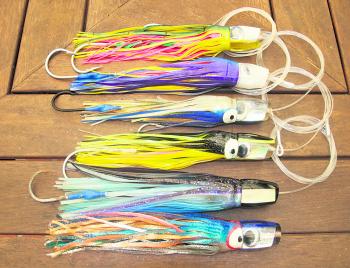
It pays to run a variety of lure colours on the day, at least until the marlin demonstrate a particular preference.
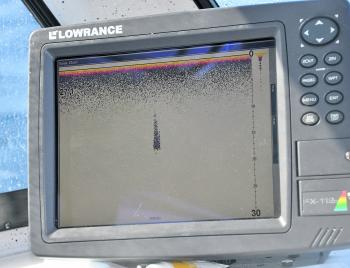
A nice patch of bait showing high in the water column. When the sounder can’t reach the bottom in deeper water, change the depth scale to 0-30 fathoms to pinpoint bait schools like this.

Circle hooks are mandatory for live baiting and trolled dead baits in organised gamefishing in Australia. They produce better hookups and are easier to use.


With a vegetable knife, make a small incision in the bait’s nose.

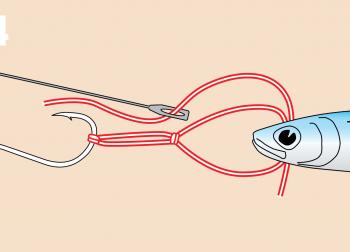

Striped marlin are spectacular, often hunt in packs, and create all sorts of mayhem as a result.




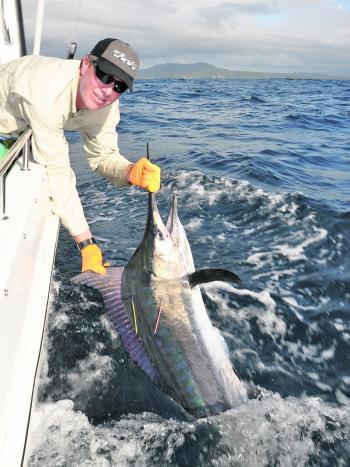
Depending on current strength and recruitment, black marlin swarm down the east coast in the summer months, sometimes pushing as far south as Victoria.
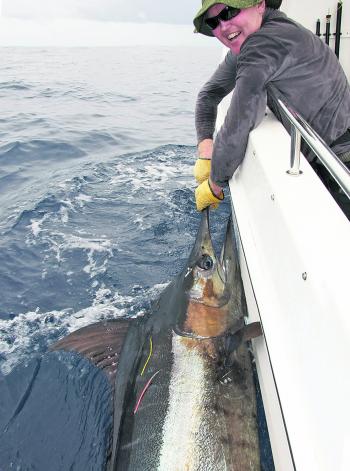
This nice blue has been tagged with both a NSW DPI tag and a Billfish Foundation tag.

Fixed guides and a roller tip are a good compromise between maintenance and friction reduction. The line will need changing more often though.
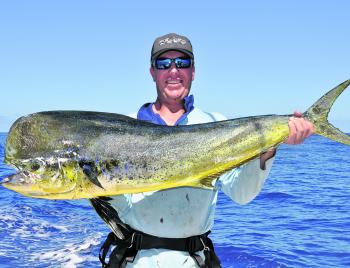
By-catch like mahimahi, yellowfin tuna and wahoo are commonplace when chasing marlin with lures and baits.

Stick with the reputable rod bucket and harness brands like Braid, Black Magic and Aftco and you’ll have them for life.
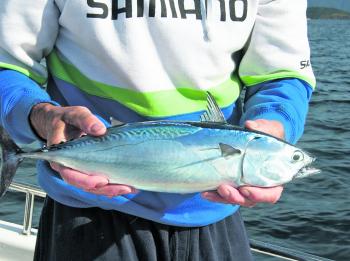
Small tuna like this frigate mackerel make excellent bait, whether fished live or rigged to skip.
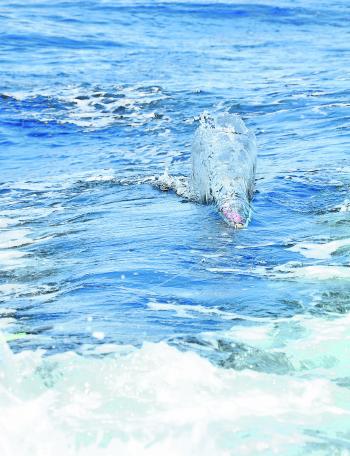
A marlin lure running in clear water rips up the surface.




